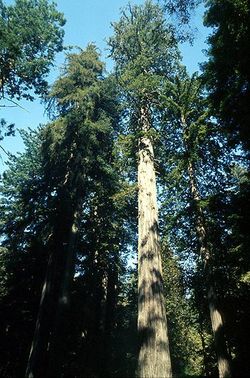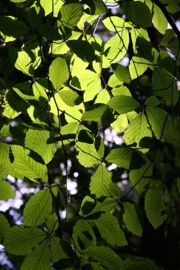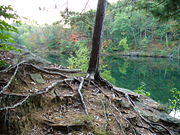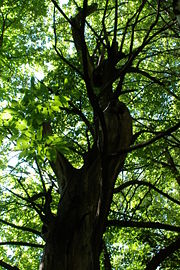Tree
2008/9 Schools Wikipedia Selection. Related subjects: Plants


A tree is a perennial woody plant. It is most often defined as a woody plant that has secondary branches supported clear of the ground on a single main stem or trunk with clear apical dominance. A minimum height specification at maturity is cited by some authors, varying from 3 m to 6 m; some authors set a minimum of 10 cm trunk diameter (30 cm girth). Woody plants that do not meet these definitions by having multiple stems and/or small size, are called shrubs. Compared with most other plants, trees are long-lived, some of them getting to be several thousand years old and growing to up to 115 m (375 ft) high.
Trees are an important component of the natural landscape because of their prevention of erosion and the provision of a specific weather-sheltered ecosystem in and under their foliage. Trees have also been found to play an important role in producing oxygen and reducing carbon dioxide in the atmosphere, as well as moderating ground temperatures. They are also significant elements in landscaping and agriculture, both for their aesthetic appeal and their orchard crops (such as apples). Wood from trees is a common building material. Trees also play an intimate role in many of the world's mythologies (see trees in mythology).
Classification

A tree is a plant form that occurs in many different orders and families of plants. Trees show a wide variety of growth forms, leaf type and shape, bark characteristics, and reproductive organs.
The tree form has evolved separately in unrelated classes of plants, in response to similar environmental challenges, making it a classic example of parallel evolution. With an estimate of 100,000 tree species, the number of tree species worldwide might total 25 percent of all living plant species. The majority of tree species grow in tropical regions of the world and many of these areas have not been surveyed yet by botanists, making species diversity and ranges poorly understood.
The earliest trees were tree ferns and horsetails, which grew in vast forests in the Carboniferous Period; tree ferns still survive, but the only surviving horsetails are not of tree form. Later, in the Triassic Period, conifers, ginkgos, cycads and other gymnosperms appeared, and subsequently flowering plants in the Cretaceous Period. Most species of trees today are flowering plants ( Angiosperms) and conifers. The listing below gives examples of many well-known trees and how they are typically classified.
A small group of trees growing together is called a grove or copse, and a landscape covered by a dense growth of trees is called a forest. Several biotopes are defined largely by the trees that inhabit them; examples are rainforest and taiga (see ecozones). A landscape of trees scattered or spaced across grassland (usually grazed or burned over periodically) is called a savanna. A forest of great age is called old growth forest or ancient woodland (in the UK). A young tree is called a sapling.
Morphology

The basic parts of a tree are the roots, trunk(s), branches, twigs and leaves. Tree stems consist mainly of support and transport tissues ( xylem and phloem). Wood consists of xylem cells, and bark is made of phloem and other tissues external to the vascular cambium. Trees may be broadly grouped into exogenous and endogenous trees according to the way in which their stem diameter increases. Exogenous trees, which comprise the great majority of trees (all conifers, and almost all broadleaf trees), grow by the addition of new wood outwards, immediately under the bark. Endogenous trees, mainly in the monocotyledons (e.g., palms and dragon trees), but also cacti, grow by addition of new material inwards.
As an exogenous tree grows, it creates growth rings as new wood is laid down concentrically over the old wood. In species growing in areas with seasonal climate changes, wood growth produced at different times of the year may be visible as alternating light and dark, or soft and hard, rings of wood. In temperate climates, and tropical climates with a single wet-dry season alternation, the growth rings are annual, each pair of light and dark rings being one year of growth; these are known as annual rings. In areas with two wet and dry seasons each year, there may be two pairs of light and dark rings each year; and in some (mainly semi-desert regions with irregular rainfall), there may be a new growth ring with each rainfall. In tropical rainforest regions with constant year-round climate, growth is continuous and the growth rings are not visible with no change in the wood texture. In species with annual rings, these rings can be counted to determine the age of the tree, and used to date cores or even wood taken from trees in the past, a practice is known as the science of dendrochronology. Very few tropical trees can be accurately aged in this manner. Age determination is also impossible in endogenous trees.
The roots of a tree are generally embedded in earth, providing anchorage for the above-ground biomass and absorbing water and nutrients from the soil. It should be noted, however, that while ground nutrients are essential to a tree's growth the majority of its biomass comes from carbon dioxide absorbed from the atmosphere (see photosynthesis). Above ground, the trunk gives height to the leaf-bearing branches, aiding in competition with other plant species for sunlight. In many trees, the arrangement of the branches optimizes exposure of the leaves to sunlight.
Not all trees have all the plant organs or parts mentioned above. For example, most palm trees are not branched, the saguaro cactus of North America has no functional leaves, tree ferns do not produce bark, etc. Based on their general shape and size, all of these are nonetheless generally regarded as trees. Sometimes size is the most important consideration. A plant form that is similar to a tree, but generally having smaller, multiple trunks and/or branches that arise near the ground, is called a shrub. However, no precise differentiation between shrubs and trees is possible. Given their small size, bonsai plants would not technically be 'trees', but one should not confuse reference to the form of a species with the size or shape of individual specimens. A spruce seedling does not fit the definition of a tree, but all spruces are trees.
Record breaking trees
The world's champion trees can be considered on several factors; height, trunk diameter or girth, total size, and age. It is significant that in each case, the top position is always held by a conifer, though a different species in each case; in most measures, the second to fourth places are also held by conifers.
Tallest trees
The heights of the tallest trees in the world have been the subject of considerable dispute and much (often wild) exaggeration. Modern verified measurement with laser rangefinders combined with tape drop measurements made by tree climbers, carried out by the U.S. Eastern Native Tree Society has shown that most older measuring methods and measurements are unreliable, often producing exaggerations of 5% to 15% above the real height. Historical claims of trees of 117 m (384 ft), 130 m (427 ft), and even 150 m (492 ft), are now largely disregarded as unreliable, fantasy or outright fraud (however, see "Tallest specimens" chapter in Eucalyptus regnans article). The following are now accepted as the top five tallest reliably measured species:
- Coast Redwood Sequoia sempervirens: 115.55 m (379.1 ft), Redwood National Park, California, United States
- Coast Douglas-fir Pseudotsuga menziesii: 99.4 m (326.1 ft), Brummit Creek, Coos County, Oregon, United States
- Australian Mountain-ash Eucalyptus regnans: 97.0 m (318.2 ft), Styx Valley, Tasmania, Australia
- Sitka Spruce Picea sitchensis: 96.7 m (317.3 ft), Prairie Creek Redwoods State Park, California, United States
- Giant Sequoia Sequoiadendron giganteum: 94.9 m (311.4 ft), Redwood Mountain Grove, Kings Canyon National Park, California, United States
Stoutest trees
The girth ( circumference) of a tree is much easier to measure than the height, as it is a simple matter of stretching a tape round the trunk, and pulling it taut to find the circumference. Despite this, UK tree author Alan Mitchell made the following comment about measurements of yew trees in a handbook "Conifers in the British Isles":
- "The aberrations of past measurements of yews are beyond belief. For example, the tree at Tisbury has a well-defined, clean, if irregular bole at least 1.5 m long. It has been found to have a girth which has dilated and shrunk in the following way: 11.28 m (1834 Loudon), 9.3 m (1892 Lowe), 10.67 m (1903 Elwes and Henry), 9.0 m (1924 E. Swanton), 9.45 m (1959 Mitchell) .... Earlier measurements have therefore been omitted."
As a general standard, tree girth is taken at 'breast height'; this is defined differently in different situations, with most forestry measurements taking girth at 1.3 m above ground, while those who measure ornamental trees usually measure at 1.5 m above ground; in most cases this makes little difference to the measured girth. On sloping ground, the "above ground" reference point is usually taken as the highest point on the ground touching the trunk, but some use the average between the highest and lowest points of ground. Some of the inflated old measurements may have been taken at ground level. Some past exaggerated measurements also result from measuring the complete next-to-bark measurement, pushing the tape in and out over every crevice and buttress.
Modern trends are to cite the tree's diameter rather than the circumference; this is obtained by dividing the measured circumference by π; it assumes the trunk is circular in cross-section (an oval or irregular cross-section would result in a mean diameter slightly greater than the assumed circle). This is cited as dbh ( diameter at breast height) in tree and forestry literature.
A further problem with measuring baobabs Adansonia is that these trees store large amounts of water in the very soft wood in their trunks. This leads to marked variation in their girth over the year, swelling to a maximum at the end of the rainy season, minimum at the end of the dry season. Although baobabs have some of the highest girth measurements of any trees, no accurate measurements are currently available, but probably do not exceed 10-11 m (33–36 ft) diameter.
The stoutest living single-trunk species in diameter, excluding baobabs, are:
- Montezuma Cypress Taxodium mucronatum: 11.62 m (38.1 ft), Árbol del Tule, Santa Maria del Tule, Oaxaca, Mexico. Note though that this diameter includes buttressing; the actual idealised diameter of the area of its wood is 9.38 m (30.8 ft).
- Giant Sequoia Sequoiadendron giganteum: 8.85 m (29 ft), General Grant tree, Grant Grove, California, United States
- Coast Redwood Sequoia sempervirens: 7.44 m (24.4 ft), Prairie Creek Redwoods State Park, California, United States.
Charles Darwin reported finding Fitzroya cupressoides with trunk circumferences of up to 40 m (130 ft) implying a diameter of about 12 m (40 ft), but this may be an anomaly as the largest known measurements are about 5 m.
An addition problem lies in cases where multiple trunks (whether from an individual tree or multiple trees) grow together. The Sacred Fig is a notable example of this, forming additional 'trunks' by growing adventitious roots down from the branches, which then thicken up when the root reaches the ground to form new trunks; a single Sacred Fig tree can have hundreds of such trunks.
Occasionally, errors may occur due to confusion between girth ( circumference) and diameter.
Largest trees
The largest trees in total volume are those which are both tall and of large diameter, and in particular, which hold a large diameter high up the trunk. Measurement is very complex, particularly if branch volume is to be included as well as the trunk volume, so measurements have only been made for a small number of trees, and generally only for the trunk. No attempt has ever been made to include root volume. Measuring standards vary (for example, Del Norte Titan below, is listed as the largest coastal redwood, but the Lost Monarch in Jedediah Smith Redwoods State Park is even larger at over 42,000 cubic feet).
The top four species measured so far are:
- Giant Sequoia Sequoiadendron giganteum: 1,489 m³ (55,040 cu ft), General Sherman
- Coast Redwood Sequoia sempervirens: 1,045 m³ (36,890 cu ft), Del Norte Titan tree
- Western Redcedar Thuja plicata: 500 m³ (17,650 cu ft ), Quinault Lake Redcedar
- Kauri Agathis australis: circa 400 m³ (15,000 cu ft), Tane Mahuta tree (total volume, including branches, 516.7 m³/18,247 cu ft)
However, the Alerce Fitzroya cupressoides, as yet un-measured, may well slot in at third or fourth place, and Montezuma Cypress Taxodium mucronatum and other giants are also likely to be high in the list. The largest angiosperm tree is a Australian Mountain-ash (Eucalyptus regnans) in Tasmania, known as the 'Two Towers' tree, with a volume of 430 m³ (15,185 cu ft).
Oldest trees
The oldest trees are determined by growth rings, which can be seen if the tree is cut down or in cores taken from the edge to the center of the tree. Accurate determination is only possible for trees which produce growth rings, generally those which occur in seasonal climates; trees in uniform non-seasonal tropical climates grow continuously and do not have distinct growth rings. It is also only possible for trees which are solid to the centre of the tree; many very old trees become hollow as the dead heartwood decays away. For some of these species, age estimates have been made on the basis of extrapolating current growth rates, but the results are usually little better than guesswork or wild speculation. White (1998) proposes a method of estimating the age of large and veteran trees in the United Kingdom through the correlation between a tree's stem diameter, growth character and age.
The verified oldest measured ages are:
- Norway Spruce Picea abies: 9,550 years
- Great Basin Bristlecone Pine ( Methuselah) Pinus longaeva: 4,844 years
- Alerce Fitzroya cupressoides: 3,622 years
- Giant Sequoia Sequoiadendron giganteum: 3,266 years
- Huon-pine Lagarostrobos franklinii: 2,500 years
- Rocky Mountains Bristlecone Pine Pinus aristata: 2,435 years
Other species suspected of reaching exceptional age include European Yew Taxus baccata (probably over 2,000 years) and Western Redcedar Thuja plicata.
The oldest reported age for an angiosperm tree is 2293 years for the Sri Maha Bodhi Sacred Fig (Ficus religiosa) planted in 288 BC at Anuradhapura, Sri Lanka; this is also the oldest human-planted tree with a known planting date.
Trees in culture
The tree has been and still is a popular cultural symbol in most of the world. Common icons are the World tree, for instance Yggdrasil, and the tree of life. The tree often represents nature or the environment itself.

